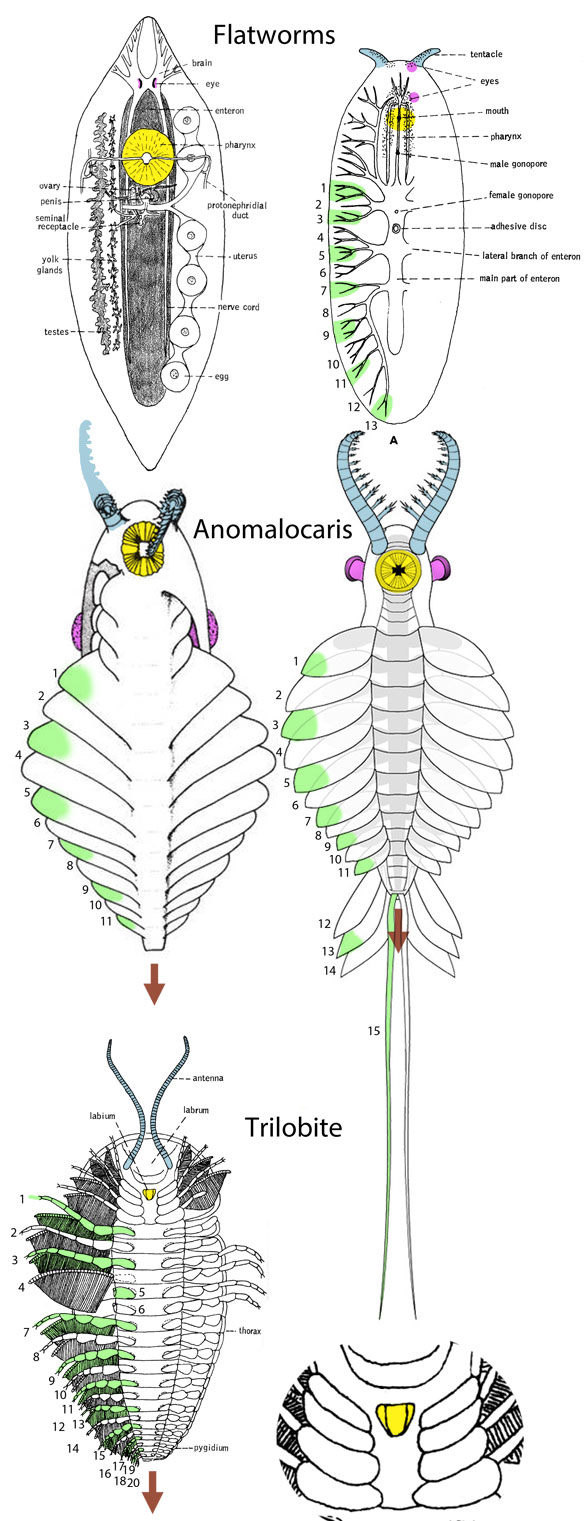Thought this would be yet another ‘heard it here first‘ report,
but see below for an overlooked Ruedemann 1916 hypothesis listing trilobites as crustaceans.
Moysiuk J and Caron J-B 2022 report:
“In addition to being among the most iconic and bizarre-looking Cambrian animals, radiodonts are a group that offers key insight into the acquisition of the arthropod body plan by virtue of their phylogenetic divergence prior to all living members of the phylum.”
This is correct. Two years ago we looked at radiodonts (Fig 1) evolving into trilobite arthropods from polyclad flatworm ancestors (Fig 2). Then in March 2022 a series of posts looked at radiodonts evolving into onychophorans and tardigrades (Fig 3), trilobites into insects (Fig 4) and other arthropods. Nice to get confirmation from a published peer-reviewed study on these, but they still need to include ancestral polyclad flatworms (Fig 5) and trilobites to understand the backstory.

Moysiuk J and Caron J-B 2022 continue:
“Nonetheless, radiodont fossils are rare and often fragmentary, and contentions over their interpretation have hindered resolution of important evolutionary conundrums. Here, we describe 268 specimens of Stanleycaris hirpex from the Cambrian Burgess Shale, including many exceptionally preserved whole-body specimens, informing the most complete reconstruction of a radiodont to date.”
Stanleycaris was first named by Pates, Daley and Ortega-Hernandez 2018. Those ‘rake-like frontal appendages’ are nothing more than flexible antennae, as in trilobites and flatworms. This has been on ongoing misidentification chiefly due to taxon exclusion (i.e. excluding polyclad flatworms Fig 5 and trilobites).

Moysiuk J and Caron J-B 2022 continue:
“The trunk region of Stanleycaris has up to 17 segments plus two pairs of filiform caudal blades. The recognition of dorsal sclerotic segmentation of the trunk cuticle and putative unganglionated nerve cords provides new insight into the relative timing of acquisition of segmental traits, the epitome of the arthropod body plan. In addition to the pair of stalked lateral eyes, the short head unexpectedly bears a large median eye situated behind a preocular sclerite on an anteriorly projecting head lobe.”
A median eye was recognized in trilobites by Ruedemann 1916, when he reported, “The median eye appears, in the majority of cases, as a single tubercle upon the glabella.”

Moysiuk J and Caron J-B 2022 continue:
“Upon re-evaluation, similar median eyes can be identified in other Cambrian panarthropods demonstrating a deep evolutionary continuity. The exquisitely preserved brain of Stanleycaris is consistent with the hypothesized deutocerebral innervation of the frontal appendages, reconciling neuroanatomical evidence with external morphology in support of an ancestrally bipartite head and brain for arthropods. We propose that the integration of this bipartite head prior to the acquisition of most segmental characters exclusively in the arthropod trunk may help explain its developmental differentiation.”
This description is in accord with prior illustrations (Figs 2–4) shown in this post, too.
I am pleased to report
that Ruedemann 1916 recognized the interrelationships of trilobites when he reported, “The entirely extinct sub-class Trilobita of the Crustaceans, comprising about 1840 species divided into some 185 genera, has always held a central place in the phylogenetic history of all classes of Crustacea. It is becoming not only more probable that the Ostracoda and Cirripedia were developed from the trilobites, but that also the insect sub phylum has taken its origin from this ancient clas sof arthropods.”
This 1916 report was published long before radiodonts were recognized as they are today and may have been a naive attempt at locating trilobites among more familiar extant taxa.
Moysiuk and Caron still need to confirm
where radiodonts came from: free-swimming polyclad flatworms, which also have brains. Moysiuk is quoted in a LiveScience (see below) online article, “It had this really ferocious apparatus of spiny claws and round mouth that made it look absolutely fierce. It also had long, rake-like spines to comb the seafloor to hunt for any buried organisms, side flaps to help it glide through the water and trident-shaped spines that project toward each other from the opposite appendage that we think it used as a jaw to crush its prey.”
This is a traditional myth. Phylogenetic bracketing nests radiodonts between polyclad flatworms and basal trilobites, which have no ‘ferocious’ body parts. The circular mouth with sharp edges is transitional between the soft circular oral/anal opening of polyclad flatworms and the grinding (between the ‘knees’) ventral central oral parts of trilobites (Fig 3). This circular oral opening remains essentially unchanged in velvet worms and tardigrades (Fig 2).

When they feed, polyclad flatworms protrude (= evert) the pharynx from the mouth.
The intestine is usually, but not always, blind. So solid waste is also expelled from this one digestive opening if no anus is present.
According to wildsingapore.com.
“Many flatworms are carnivores that prey on tiny animals (protozoa, copepods, worms) or feed on immobile animals such as bryozoans, ascidians and molluscs. Being flat, they slip easily between the shells of bivalves and some flatworms are considered pests of oyster farms. Some are scavengers, feeding on dead animals.”
Based on phylogenetic bracketing the above panorama of feeding styles most likely characterizes that of radiodonts. As in flatworms, radiodonts lacked hinged mouth parts. So they were not capable of ferocious predation on large, mobile, armored animals. They were key transitional taxa in the evolution of several arthropod and velvet worm clades.
References
Moysiuk J and Caron J-B 2022. A three-eyed radiodont with fossilized neuroanatomy informs the origin of the arthropod head and segmentation. Current Biology 32(115):3302–3316. online.
Pates S, Daley AC and Ortega-Hernández J 2018. Reply to Comment on “Aysheaia prolata from the Utah Wheeler Formation (Drumian, Cambrian) is a frontal appendage of the radiodontan Stanleycaris” with the formal description of Stanleycaris. Acta Palaeontologica Polonica. 63 (1): 105–110.
Ruedemann R 1916. ON the presence of a median eye in trilobites. New York State Museum.
wiki/Stanleycaris
ivescience.com/three-eyed-cambrian-fossil-stanleycaris

